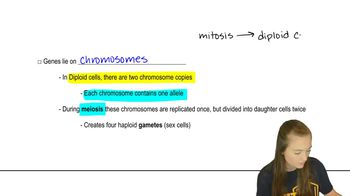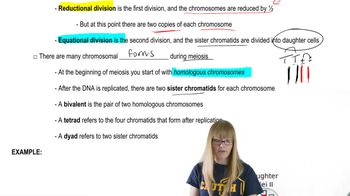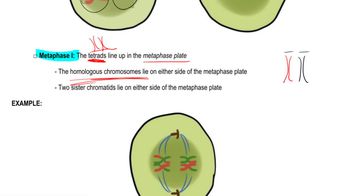During which stage of meiosis do sister chromatids separate?
Table of contents
- 1. Introduction to Genetics51m
- 2. Mendel's Laws of Inheritance3h 37m
- 3. Extensions to Mendelian Inheritance2h 41m
- 4. Genetic Mapping and Linkage2h 28m
- 5. Genetics of Bacteria and Viruses1h 21m
- 6. Chromosomal Variation1h 48m
- 7. DNA and Chromosome Structure56m
- 8. DNA Replication1h 10m
- 9. Mitosis and Meiosis1h 34m
- 10. Transcription1h 0m
- 11. Translation58m
- 12. Gene Regulation in Prokaryotes1h 19m
- 13. Gene Regulation in Eukaryotes44m
- 14. Genetic Control of Development44m
- 15. Genomes and Genomics1h 50m
- 16. Transposable Elements47m
- 17. Mutation, Repair, and Recombination1h 6m
- 18. Molecular Genetic Tools19m
- 19. Cancer Genetics29m
- 20. Quantitative Genetics1h 26m
- 21. Population Genetics50m
- 22. Evolutionary Genetics29m
9. Mitosis and Meiosis
Meiosis
Problem 2b
Textbook Question
Our closest primate relative, the chimpanzee, has a diploid number of 2n = 48. For each of the following stages of M phase, identify the number of chromosomes present in each cell.
Meiotic metaphase I
 Verified step by step guidance
Verified step by step guidance1
Understand that the diploid number (2n) represents the total number of chromosomes in a somatic cell of the organism. For chimpanzees, 2n = 48, meaning there are 48 chromosomes in a diploid cell.
Recall that meiosis is a type of cell division that reduces the chromosome number by half, producing haploid (n) gametes. However, in metaphase I of meiosis, the cell is still diploid because homologous chromosomes are paired but not yet separated.
In meiotic metaphase I, homologous chromosomes align at the metaphase plate. Each homologous pair consists of two chromosomes, and since the cell is still diploid at this stage, the total number of chromosomes remains 48.
Note that while the number of chromosomes remains 48, each chromosome consists of two sister chromatids because DNA replication occurred during the S phase of interphase prior to meiosis.
Conclude that the number of chromosomes in a cell during meiotic metaphase I for a chimpanzee is 48, with each chromosome consisting of two sister chromatids.
 Verified video answer for a similar problem:
Verified video answer for a similar problem:This video solution was recommended by our tutors as helpful for the problem above
Video duration:
1mPlay a video:
Was this helpful?
Key Concepts
Here are the essential concepts you must grasp in order to answer the question correctly.
Diploid Number
The diploid number (2n) refers to the total number of chromosomes in a somatic cell, which includes two sets of chromosomes, one from each parent. In the case of chimpanzees, the diploid number is 48, meaning they have 24 pairs of homologous chromosomes. Understanding diploidy is crucial for determining chromosome numbers during various stages of cell division.
Recommended video:
Guided course

Diploid Genetics
Meiosis
Meiosis is a specialized type of cell division that reduces the chromosome number by half, resulting in four haploid cells from one diploid cell. It consists of two sequential divisions: meiosis I and meiosis II. During meiosis I, homologous chromosomes are separated, which is essential for producing gametes with half the genetic material of the parent organism.
Recommended video:
Guided course

Meiosis Overview
Metaphase I
Metaphase I is a stage in meiosis where homologous chromosome pairs align at the cell's equatorial plane. At this point, each pair consists of two sister chromatids, and the cell is still diploid. For chimpanzees, during meiotic metaphase I, there would be 24 pairs of chromosomes, totaling 48 chromosomes, as they have not yet been separated into haploid cells.
Recommended video:
Guided course

Meiosis Steps
Related Videos
Related Practice
Multiple Choice
604
views
4
rank


